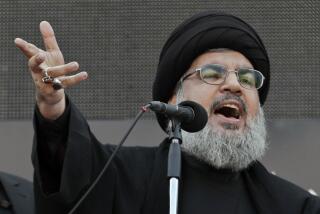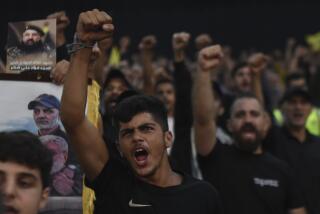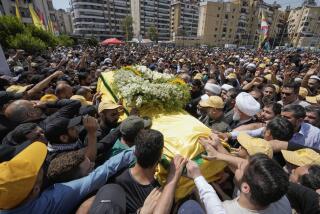Taliban dealt a blow with top commander’s slaying
- Share via
KABUL, AFGHANISTAN — The Taliban movement suffered a significant setback with the death of its top operational commander, Mullah Dadullah, but the brutal tactics he pioneered probably have left a lasting imprint on the insurgency, military officials and analysts said Sunday.
Dadullah, one of the senior-most Taliban figures to be killed by Western forces in more than five years of fighting, died Saturday in a U.S.-led military operation in the southern province of Helmand, U.S. and Afghan officials disclosed Sunday.
Although subordinate to the movement’s supreme leader, Mullah Mohammed Omar, Dadullah was considered the commander in chief of Taliban forces, in charge of day-to-day military operations.
A flamboyant, one-legged figure with a penchant for casting himself in graphic Taliban recruiting videos, Dadullah had escaped death so many times that, to dispel any doubts, Afghan authorities displayed his blood-splattered corpse to reporters in the southern city of Kandahar. The body was wrapped in purple sheets and bore bullet wounds to the head and torso.
Those shown the body confirmed that, like Dadullah, it was missing a left leg. They also said the face was recognizable from televised interviews Dadullah had provided, a departure from the secrecy practiced by most other senior Taliban figures.
Dadullah, one of the most feared and ruthless Taliban commanders, was believed to have been the driving force behind the adoption of tactics such as suicide bombings, abductions and assassination-style killings, including beheadings -- all of which increased sharply in the last year.
Analysts said that even with Dadullah’s death, Taliban fighters would probably press ahead with such attacks, in part because they had proved the most successful way to harry North Atlantic Treaty Organization forces and intimidate the Afghan populace.
“All this is part of the repertoire now, and they will not change their minds as a result of Dadullah’s elimination,” said Hassan Abbas, a research fellow at the Kennedy School of Government at Harvard University.
Nonetheless, he and others characterized Dadullah’s slaying as a milestone in the U.S.-led coalition’s battle against the Taliban, whose fighters have managed to reorganize and regroup after their government was toppled in 2001.
The killing of Dadullah, who was thought to be in his 40s, was announced by Said Ansari, a spokesman for Afghanistan’s intelligence service, and later confirmed by NATO’s International Security Assistance Force.
Dadullah “will most certainly be replaced in time, but the insurgency has received a serious blow,” ISAF said in a statement.
Afghan security forces also took part in the operation, which was launched when Dadullah “left his sanctuary,” the coalition said without providing details. Dadullah and other senior Taliban leaders were thought to have crossed freely into Pakistan, using the border-straddling tribal areas as a staging ground for attacks in Afghanistan.
The presence of Taliban fighters in Pakistan is a politically explosive issue, both in the West and between the neighboring countries. Adding to tensions, Pakistani and Afghan troops Sunday engaged in a rare firefight along the border. The two sides blamed each other for starting the shooting, in which at least two Afghans were killed.
Pakistani President Pervez Musharraf denies that his country has given safe haven to Afghan insurgents. But there have been strong indications that Pakistani intelligence is aware of senior Taliban commanders’ comings and goings out of Pakistan’s restive Waziristan region.
In late February, Pakistani authorities arrested Mullah Obaidullah Akhund, the former Taliban defense minister, in the southern city of Quetta. The action coincided with a visit by Vice President Dick Cheney and came after senior Bush administration officials said Pakistan was not doing enough to rein in militant activity in the tribal areas.
Dadullah’s replacement, almost certain to be an ethnic Pashtun like himself, will have to win the respect of the various factions within the movement, a process that could take some months and may disrupt insurgent operations in the short term, several diplomats and military officials said.
Helmand, the opium-producing heartland where Dadullah was killed, has been the scene of heavy fighting in recent weeks. NATO forces have launched a major offensive against the insurgents, but the Taliban have staged mainly hit-and-run attacks, avoiding direct battlefield confrontations when they can.
Although NATO forces have been frustrated at times by their inability to flush the Taliban into the open, they have managed to track and kill some important commanders, such as Mullah Akhtar Mohammed Osmani, who was killed in an American airstrike in December.
Dadullah was a veteran of mujahedin battles against invading Soviets in the 1980s, a conflict that cost him his leg. He came to prominence in the 1990s and gained a reputation for military prowess, but also for almost baroque acts of cruelty.
During the Taliban reign, he was said to have presided over the stoning of women accused of licentious behavior, public hangings and revenge killings encompassing entire villages. He was notorious for personally ordering the massacre of civilians from the Hazara ethnic group in the late 1990s.
Special correspondent Faiez reported from Kabul and staff writer King from Istanbul, Turkey.
More to Read
Sign up for Essential California
The most important California stories and recommendations in your inbox every morning.
You may occasionally receive promotional content from the Los Angeles Times.










